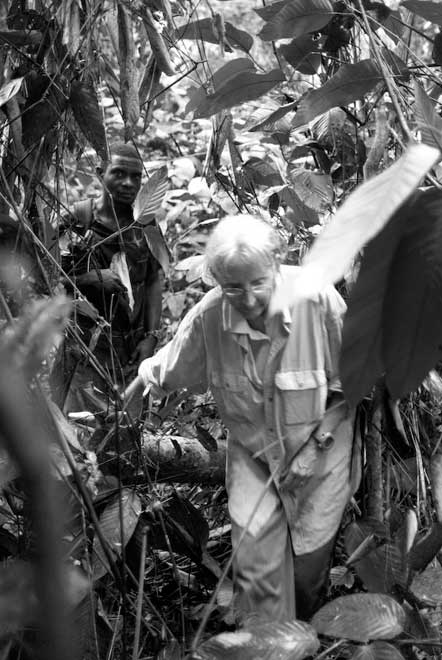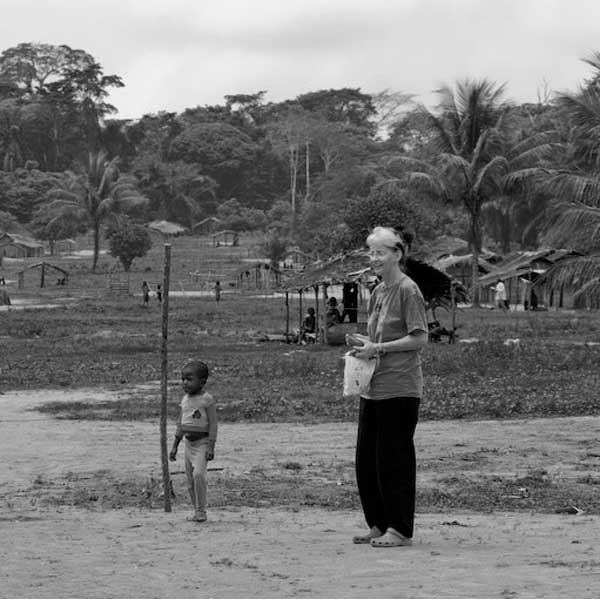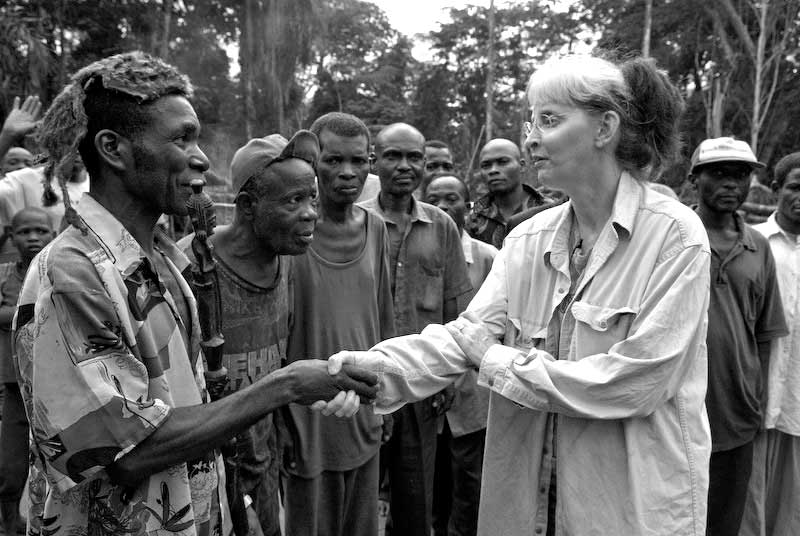Page 5
This article and all associated photographs is the property of Dr. Jo Thompson & may not be reproduced in whole or in part without her express written consent.
The Lukuru Program - Part 1
Follow a Star
by Dr. Jo Thompson
“Dreams are like stars...you may never touch them, but if you follow them they will lead you to your destiny.” - Unknown
On countless evenings long after the sun has set at the equator, I have looked up into the African night and known that the star-filled sky is witnessing a timeless scene around me. My life in the heart of the Democratic Republic of Congo (DRC) mirrors the life of centuries gone by. So it was following a star that I am now transported back in time to this ancient place in the primordial jungle of darkest Africa. Here images of a vibrant people, proud to maintain their ancestral lifestyle, living in the dense equatorial rainforest and moving slowly to the sensual rhythms of daily survival are reality. This is my destiny.

Trail blazing through dense jungle
vegetation of the Lukuru where no road connects distant destinations.
In addition to earning my Doctorate, Master, and Bachelor degrees, I have worked as a conservation biologist and gained an intimate knowledge of the most primitive people at the heart of the DRC. Over the past nearly 20 years I have been a field scientist working in the DRC to preserve one of the rarest species of Great Ape and other important wildlife of conservation concern. It has been my privilege to live amongst and know some of the most unchanged and isolated people on the continent. My study site and Congo home is known as the Lukuru. Through my work I have repeatedly traveled across the width and breadth of the 23,908 km2 area (9,230 square miles), which makes up the Lukuru Project zone of influence and on occasion to areas beyond. Conservation in the hinterlands of the Congo Basin is about people. During my many expeditions overland I was able to closely observe the indigenous village dogs as a baseline indicator of the local human condition. I recorded information about their status and have notated sites where dogs looked particularly well conditioned.

There are still a few villages alive in the heart of the darkest jungle.
In addition to specializing in the natural history of the Congo, my particular area of interest is population biogeography. Biogeography is the branch of science that focuses, in part, on the geographical distribution of species or unique types of animals characterized by geography and their relationship with humans in their environment. So, it was an obvious consequence that I would notice the indigenous dogs of my living space. Basenjis are a geographical breed adapted to the environment, human lifestyle, and ecological niche in which they were first identified. As a natural breed their type developed prior to the "modern dog era." When originally "discovered" by the outside world, they were named "Congo Terriers," referring to the geographic region where they originated, as was the fashion of the time.
In years past, I cared for and lived with my own dog of local origin, at the very core of the traditional range of the basenji. So, on 5 April 2006, during preparations to return to the United States, I contacted the American Kennel Club to inquire about the process of including new blood lines of purebred basenjis from the breeds Country of Origin into the official registry of the breed. The AKC immediately put me in touch with Sally Wuornos, then President of the Basenji Club of America. Sally generously corresponded with me, informing me that the BCOA board would have to first consider my appeal. At her request, I sent Sally pictures of my dogs with location details from the villages where I work and live. From her experience, she was able to identify and confirm that my animals are "certainly basenjis." Although writing from Kinshasa, the DRC capital city, I was prompted by Sally to introduce myself to the basenji fancy.

The Congo is based on a culture
of personal relationships and
especially respect for the village
elders who preserve ancestral ways.
My strong family ties have always been a rudder to steer with on my life journey. Growing up, I remember my father loved basenjis. To him they represented a contact with human life long past; as he said, "a bridge to the world we can't in any other way reach" ... or so he thought at that time. He likened basenjis to little souls that "are as they always were"; something deep, dark and mysterious. Intellectually, he felt that they might be a contemporary connection to domestic canine origins. But, his affection for the breed was at a distance. Then, several years ago he had the opportunity to personally meet and interact with a domestic basenji. It had a very nasty temperament and totally turned my father off his life-long affection for the breed and shattered the mystique he had held until he met the Lukuru imports.
I have worked with and around dogs all my life. Back in the late 1970's I worked with a breeder as his handler. Showing his Shar Pei's, I took home several blue ribbons over the course of nearly four years. Between 1978-1982 I trained guide dogs for the blind after having raised, obedience trained, and socialized puppies specifically for that program during my high school years. Little did I know then that those experiences would come to serve me well into my future.
The next installment about the Lukuru program will take the reader into the time of our first importations. Stay tuned.